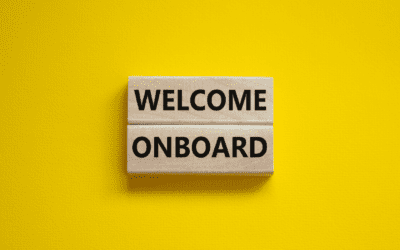Getting new team members up to speed can be a major hurdle for employers and employees. Did you know that a well-executed onboarding process can significantly boost employee retention?
This article dives into ten standout onboarding process examples and strategies from top companies, giving you the playbook to welcome your new hires successfully.
Key Takeaways
- Good onboarding programs make new hires feel welcome and help them understand their roles quickly. This leads to more productive employees staying with the company longer, saving businesses money.
- Top companies like Twitter, Google, and Zappos use unique strategies such as welcome kits, buddy systems, and culture fit emphasis to help new employees blend into their roles smoothly.
- Onboarding activities like icebreakers, scavenger hunts, time with senior leaders, decorated office spaces, and interactive courses excite people about work. They also build strong team connections from day one.
- Companies focusing on effective onboarding see enormous benefits, such as happier teams working well together. This can lead to more success in business because employees stick around longer.
- Each company has its way of welcoming newcomers, but what’s key is creating a memorable experience that immediately sets workers up for success.
Understanding Employee Onboarding Programs
Employee onboarding programs serve as a bridge for new hires to join a company’s culture and workforce. They are well-planned introductions to the tools, people, and knowledge that newcomers need.
These programs help new employees feel welcome and get up to speed quickly.
Good onboarding makes sure each person knows what the company expects from them. It covers everything from completing paperwork to meeting teammates. New team members learn about goals, values, and how their work fits into the big picture.
They also find out where they can grow within the company.
Key Elements of Effective Onboarding
As new hires embark on their journey within a company, the building blocks of an effective onboarding program are crucial for ensuring a smooth transition. It’s about laying out clear goals, making them feel welcome with thoughtful kits and announcements, and engaging them through hands-on learning experiences that foster immediate involvement in the company culture.
Instant goal setting
Jump right into action with instant goal setting. It gives new employees clear objectives from day one. This way, they know their expectations and can hit the ground running. Think of it like a roadmap for their first few weeks or months.
With each step outlined, they feel confident about their role and how to excel in it.
This approach is more than just a good start; it creates lasting engagement. New hires get to dive into the company culture headfirst, aligning with its values quickly. They’re not left guessing – they have concrete goals that guide them toward success and make them feel part of the team sooner.
Plus, this method has been linked to keeping folks around longer and boosting overall productivity—big wins for any business!
Welcome kit
A welcome kit greets new hires with all the essentials they need. It’s packed with info about company values and expectations right from the start. You’ll find onboarding tools, an employee handbook, and other key documents inside.
This isn’t just a bunch of papers; it’s your first taste of the corporate culture.
Your welcome kit is like a treasure map to success in your new role. It helps you blend into the work culture smoothly and quickly. Next up comes making some noise—let’s talk about how a company-wide announcement ramps up the excitement for everyone involved!
Company-wide announcement
Let everyone know there’s a new team member on board! Kicking off with a company-wide announcement is key. It introduces a fresh face and makes them feel like part of the family right away.
These shout-outs can happen in various fun ways—maybe through an email blast with their photo, at the start of a team meeting, or even on social media platforms if your business loves public cheers.
Crafting this greeting takes care and thought. Share some cool facts about the newbie – like their love for mountain biking or how they’re a cookie-baking champ. It builds excitement and lays down the first bricks of connection between colleagues.
And don’t forget, it’s not just about saying “hello.” You’re also signaling to current employees that you value bringing in new talent and are growing stronger as a community.
Interactive courses
Interactive courses are a game changer in new employee onboarding. They invite employees to learn about their new roles and company culture. Online courses and e-learning make it easy for newcomers to understand what they need to do.
These tools are great because they let people learn at their own pace.
These courses can have videos, quizzes, and even games that teach the job’s ins and outs. New hires get hands-on experience through simulations that mirror real tasks they’ll face.
It helps them feel ready faster. Plus, interactive experiences boost teamwork by connecting newbies with peers who can help them out.
Top 10 Examples of Effective Onboarding Processes
Before diving into the nitty-gritty, let’s set the stage with game-changing onboarding strategies. From tech giants to savvy startups, these top 10 companies have nailed down processes that not only welcome new hires but truly integrate them into the fabric of their organizations.
Their methods blend innovation and practicality—think learning by immersion, personalized workspaces, and mentorship magic—that makes for an unforgettable first chapter in any employee’s journey.
With these examples as our compass, you’re about to explore how onboarding can be more than just a checklist; it’s the start of building loyalty and driving success from day one.
Twitter: Welcome initiatives
Twitter (X) takes the start of a new job seriously. They roll out the welcome mat with initiatives that make new hires feel part of the team from day one. Each newcomer gets immediate tasks to jump into, helping them understand their role quickly.
Alongside these tasks, Twitter prepares a welcome kit filled with goodies and company info. This sparks excitement and makes employees eager to contribute.
As they’re called on Twitter, New Tweeps join in on interactive courses, too. These aren’t just any old classes—they’re designed to be fun and engaging, showing off the company’s vibrant culture.
By inviting newbies to learn through play, Twitter ensures their first experience is both educational and memorable. And it doesn’t stop there; everyone in the office knows when someone new has arrived, thanks to a company-wide announcement celebrating each arrival.
It’s all about starting strong—setting goals instantly and ensuring no one feels like another number.
Google: Preparation for new hires
Moving from Twitter’s welcoming initiatives, Google takes new hire preparation to another level. Their onboarding process stands out in the tech world. It is 25% more effective than comparable programs.
The secret? A blend of personalized guidance and team involvement far beyond HR and hiring managers.
Right from day one, Google gets busy setting up its newcomers for success. Each new employee gets a preboarding package that includes company swag to make them feel part of the team immediately.
They’re paired with an onboarding buddy for mentorship and support. This buddy system ensures someone is always there to help navigate the first few weeks. Office hours, job-specific training, and regular check-ins are standard fare here, ensuring every fresh face quickly becomes an integral part of the Google family.
LinkedIn: Comfortable workspace setup
LinkedIn knows a smooth start matters. They set up workspaces for new hires that feel like home, packed with all the essentials. Think comfy chairs, tech tools at your fingertips, and personalized touches.
A good desk space can make a big difference in how happy and productive someone is from day one.
By creating this kind of welcome show, LinkedIn immediately values its team’s well-being. It also encourages fresh talent to dive into their roles with confidence and enthusiasm.
As they settle in, attention turns to mentorship programs where rookies meet pros who help steer their career development.
Microsoft: Implementing a buddy program
Microsoft knows how to make new hires feel at home. They pair them up with a buddy. This isn’t just any coworker; it’s someone ready to guide rookies through the maze of an enormous company like Microsoft.
New employees get the lowdown on everything from where to find the best coffee to how the filing system works.
Having a buddy can turn a challenging first month into smooth sailing. It builds lasting bonds and makes work feel more human, especially when you’re starting out. Plus, with Microsoft’s NEO Teams app template, even virtual newbies can have a digital wingman by their side—proving distance is no barrier to employee engagement or friendship forming in today’s workplace!
Pinterest: Inclusion in important projects
Moving from the buddy system to hands-on involvement, Pinterest takes a unique approach. New hires dive right into meaningful projects. This way, they feel part of the team from day one.
They’re not just watching; they’re doing real work contributing to the company’s goals.
Pinterest believes in inclusive research, too. It brings together different views for stronger results. Early career employees get a say in big decisions because everyone’s perspective matters at Pinterest.
This practice boosts employee experience and fosters talent development within an engaging learning environment.
Netflix: Learning by doing approach
Netflix throws new hires into the action from their first day. They adopt a “learning by doing” approach that values freedom and responsibility. This method sets employees up for immediate engagement in the company’s dynamic environment.
It trusts them to handle important tasks early on, reflecting Netflix’s confidence in its talent attraction and retention strategies.
New team members learn fast by participating directly in projects. They are encouraged to make decisions and contribute ideas as part of Netflix’s reinvention of HR and onboarding.
This empowers them, boosting job satisfaction while showcasing Netflix’s innovative culture. Ready for more diversity? Let’s explore Zapier’s take on remote work onboarding next.
Zapier: Remote work onboarding
Just as Netflix focuses on hands-on experiences, Zapier taps into the power of remote work for its onboarding process. They understand that getting a new job can be tough when you’re not in an office.
To make things smoother, they’ve built an onboarding program that helps employees feel connected right from home. This means setting up new hires with tools and resources to master asynchronous communication.
Zapier gives each newcomer a virtual welcome kit filled with information to get them started. The team works hard to ramp up productivity quickly, ensuring no one feels left out.
New hires learn about their roles through interactive learning and by joining real projects; this helps them become part of the team fast. With practices like these, it’s clear why Zapier is known for excellence in virtual employee integration.
Buffer: Transparency and culture immersion
Buffer takes pride in its clear onboarding process. New team members get a real feel for the company’s values from day one. The culture isn’t just talked about; it’s lived and breathed.
New hires dive right into what makes Buffer unique. They see how decisions are made and why transparency matters so much.
The whole team helps with cultural immersion. This means joining meetings, sharing ideas openly, and getting to know everyone’s roles. Hires learn not by watching but by doing, which cements Buffer’s way of working deep into their professional habits.
This hands-on approach quickly fosters a sense of belonging, breaking down walls and building up trust within teams immediately.
Miro: Product engagement
Miro turns new hires into product pros fast. They dive into hands-on tasks, using the company’s tools from day one. This approach gets team members up to speed quickly. It helps them connect with Miro’s features and capabilities deeply.
The company has grown through three phases: Startup, Hyper-growth, and Expansion. Each phase changed how they teach newcomers about their platform. New employees feel like part of the team faster thanks to this focus on product engagement.
They’re ready to confidently contribute to projects, bringing fresh ideas that help grow the business.
Zappos: Culture fit emphasis
Moving from product engagement at Miro to the unique approach of Zappos, it’s clear that culture is king. Zappos takes onboarding to another level by focusing heavily on whether new hires will mesh well with their organizational culture.
They strongly emphasize their brand of customer service right from the start. New employees spend time getting to know the core values that make Zappos stand out in the internet marketplace.
Their hiring process isn’t just about skills and experience; it’s about personality and passion, too. At Zappos, they believe happy workers provide better service, so they look for people who will contribute positively to their workplace vibe.
This dedication helps ensure every team member is capable and genuinely excited to be part of the company’s family-like atmosphere.
Innovative Onboarding Activities
Dive into the world of creative onboarding as we explore activities that transform new hires from wide-eyed rookies to engaged, productive team members—keep reading for a peek at innovation in action.
Icebreaker activities
Icebreaker activities are all about making new hires feel at home and getting them to mingle with the team. Picture everyone in a room, laughing over an onboarding trivia quiz or swapping stories during discussion topic shuffles.
These icebreakers remove the awkwardness of first-day formalities. They also create a friendly atmosphere where people can relax and open up.
Coworker feud games or creative welcome videos add that extra spice to kick off professional relationships on a high note. These games encourage teamwork and allow everyone to show off their personalities.
Icebreakers make introductions fun, helping new employees settle in quickly with their colleagues. They’re not just games but the building blocks for strong team dynamics from day one.
Scavenger hunt
Scavenger hunts turn the first day at work into an adventure. New hires get a fun peek into their new world as they search for clues and complete tasks. These activities lead them through the office, introducing them to colleagues and showing off key spots like the break room or print station.
It’s more than just a game; it teaches important locations and faces in a memorable way.
Imagine starting your job with a treasure map of sorts—only the “treasures” are bits of knowledge about your new company. Digital scavenger hunts can be especially thrilling for those working remotely, guiding them through virtual spaces and digital tools with excitement tucked around every corner.
For all employees, these quests make learning lively, foster connections and set everyone up for success right from the start.
Scheduled time with senior leadership
Meet the big bosses! New employees get special time with top leaders during onboarding. This isn’t just a quick hello, either. It’s a chance to chat, ask questions, and learn what makes the company tick straight from those in charge.
Leaders share their vision, goals, and even some company secrets that help newbies quickly feel part of the team.
Imagine sitting down with the CEO or other senior figures to talk about your ideas for the company. You get insights into leadership skills and organizational culture that books can’t teach you.
Plus, this face-to-face time boosts motivation big time—it shows that every person matters in shaping the future of where they work.
Decorated office space
A decorated office space shows new hires they are welcome. It can spark creativity and make them feel part of the team immediately. Think bright colors, comfortable furniture, and personalized touches.
These details show the company cares about its employees’ work environment.
Next up, a buddy system pairs newcomers with seasoned pros to help them settle in. This gives new hires a go-to person for all their questions. It’s a great way to start building relationships within the team.
Buddy system
After personalizing their space, new hires can dive into the company culture with a buddy system. This method pairs each newcomer with an established employee. Buddies provide guidance and support as the new team member learns their way around.
They answer questions, introduce them to others, and help them feel at home. Microsoft found that buddies boost satisfaction for new employees.
The buddy system doesn’t just stop at one person. New hires often get three types of buddies: Leader Buddy, Role Buddy, and Culture Buddy. Each one plays a different part during the first six weeks on board.
The Leader Buddy shares insights about leadership styles within the organization. A Role Buddy focuses on specific job-related skills and goals. Meanwhile, a Culture Buddy helps the newcomer understand company values and traditions.
This triple approach speeds up learning and growth on the job while giving new employees a sense of belonging right from the start.
The Impact of Effective Onboarding on Business
Good onboarding turns newcomers into loyal workers. This means companies don’t have to replace people as often, saving money and keeping knowledge inside the business. Newcomers who feel part of the team from day one work harder and develop better ideas.
They understand their roles quickly and start contributing to projects right away.
Structured onboarding programs lead to happier teams that do great work together. Companies with solid onboarding see a big jump in money made because their employees are more connected to their jobs.
They also spend less training new people because well-onboarded employees stay longer. Happy, dedicated workers drive businesses ahead, making them leaders in any market.
Conclusion
Let’s wrap this up. Each company we peeked at crafts a unique welcome for their newbies. From Twitter to Zappos, they show there’s no one-size-fits-all regarding onboarding.
What matters is the experience leaves a lasting impression. Fresh hires deserve that warm, exciting start – it makes all the difference!



0 Comments